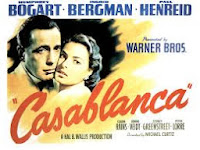Some of the more generally subscribed film review magazines are:
- Total Film
- Empire
- Sight and Sound (among the more established and educated film buffs)
With such cinemas as Vue, Odeon and Cineworld providing their own magazines featuring film reviews. These different styles of magazine will have differently constructed layouts, as well as style, content and mode of address for their reader.

Total Film and Empire are direct competitors with each other, both producing similar style reviews with a more casual, relaxed and often comical and informal mode of address with their reader. this is how they would attract their audience which is the general movie goer, with a more expanded review than what you would find in a news papers, featuring graphics to help explain these, often coming in the form of graphs or diagrams that aren't always used in a serious manner. one example of this by Total Film is the "predicted interest curve" which suggests your mood based on the film at specific stages within the film.
Moreover, these types of magazine film review would also feature photographs or stills from the film which would fall in line with the columns of text, and in some cases take up most of the page so as to downsize the amount of writing necessary for the article itself.
There are 14 different components that make up a magazine review article, in most cases, of which are:
Section Titles
Headlines
Strap Lines
Introduction
Subheadings/breakout paragraphs
Columns
Pictures
Graphics and logos
Font and typography
Breakout boxes
Call to action
Byline
Issue Info
Image Caption

As with film posters, not all of these will be used. It is the way they are used, or omitted that will indicate the audience content and style of the piece itself.
This review contains 11 of the components, including Section title, Headline, strap line, photographs, graphics, font and typography change, break out boxes, byline, introduction and Issue info and of course, columns.
all of these components are vital for dragging in the reader and encapsulating them in the review article, oft times, making or breaking the film itself, and as to whether people want to go see it.
The mode of address that is given by this review article, is one of informality, it displays enough written codes about the synopsis of the movie and the films merits and its faults.
Moreover, the strap line used is "sex lies and toupee tape", this is reminiscent of the song "sex and drugs and rock and roll", which describes the life of a rock star but has altered it for Liberace, which assumes the reader is old enough to know where the reference comes from.

Unlike "Empire", total film displays all 14 of the general components for a magazine review article: section title, headline, strap line, photographs, breakout boxes, by-line, issue info, graphics, introduction, logos, breakout paragraphs, call to action and columns.
This issue contains a more compact article that focuses more on the images than the review itself. this is designed to draw in the not so active viewer that wants to get to the point rather than read a dissertation on why you should watch this film.
The mode of address is completely informal, more so than Empire, the pictures take up most of the review and uses of comedic captions are used to entertain as well as inform.
Some semiotics that can be seen on this page is the way that character is moving on the image. Being in mid movement it highlights subliminally that there is exciting action in the film, as it has been freeze framed on that exact moment in the film, as if the character has realised something important.
Depending on the Genre of short film we will aim to create, more likely a less serious one, I believe we can take inspiration from this article and its informal but definitely informative way to attract and inform the audience.

These examples of deconstructed magazine review articles.
This is an example of the REVUE article by VUE cinema. some of the components that are absent from this review are graphics and byline because of the informal nature of the article. the lack of byline suggests to the reader that anyone could have written the article, making it a glorified movie poster. the pictures that dominate the page also suggest that the article isn't just about the writing as much as its about promoting the film.

this article takes a different approach however. unlike the VUE article, this review contains some pictures but is dominated by the extensive analytical written codes of the review itself. this gets the message across to the reader that this is for the more educated mind and doesn't take a biased stand point due to the amount different paragraphs that contain different written codes such as context, references and analysis... etc.
This article from total film displays all of the conventions of a generic movie review article. it takes themes from both the Sight and Sound article and the REVUE article. the article is very informal, using comedic straplines and image captions to draw in a layman audience.
however, unlike the review article it does give an analysis of the film, rather than just pick out all the good parts of the film to bring in its audience, because unlike the article from VUE this article isn't catering for an audience that could damage their profits by being put of from watching the film altogether by the article.
unlike the sight and sound article, this is intended to inform rather than educate, which leaves it open to any audience and will be respected more than the VUE article would be.















+Advance_1.jpg)


















